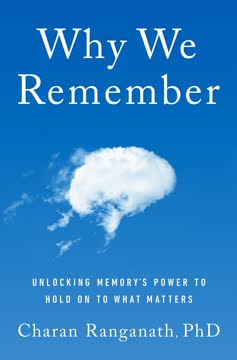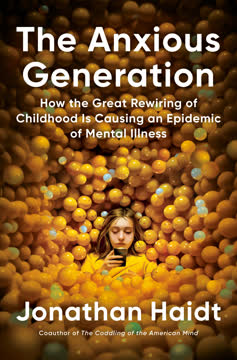Key Takeaways
1. Art and Aesthetics: Essential for Survival
But we now have scientific proof that the arts are essential to our very survival.
Beyond Entertainment. The book challenges the common perception of art as mere entertainment or a luxury, presenting it as a fundamental component of human existence, supported by scientific evidence. It posits that art, in its myriad forms, is not just enjoyable but crucial for our physical, mental, and social well-being.
Neuroarts Defined. The authors introduce the emerging field of neuroarts, which studies how aesthetic experiences affect our biology. Advances in technology allow researchers to explore the impact of art on the brain and body, revealing that the arts and aesthetics can transform lives by altering our basic biology.
Everyday Applications. The book emphasizes that simple, accessible "acts of art" can significantly enhance daily life. From using specific scents to relieve nausea to calibrating light sources to adjust energy levels, the microdosing of aesthetics is presented as a practical way to support physical and mental health.
2. Cultivating an Aesthetic Mindset: Awareness and Purpose
An aesthetic mindset is simply the ways in which you are aware of the arts and aesthetics around you, and how you bring them into your life with purpose.
Four Key Attributes. The book introduces the concept of an aesthetic mindset, characterized by curiosity, playful exploration, keen sensory awareness, and a drive to engage in creative activities. These attributes enable individuals to be more present and attuned to their environment, fostering a deeper connection to sensory experiences.
Aesthetic Mindset Index. The authors provide a short survey, the Aesthetic Mindset Index, based on a research instrument, to help readers assess their aesthetic responsiveness. This tool measures aesthetic appreciation, intense aesthetic experience, and creative behavior, offering a snapshot of one's current engagement with aesthetics and the arts.
Being Present. The aesthetic mindset encourages individuals to be present and attuned to their environment, fostering an ongoing connection to sensory experiences. This awareness opens the door to creating art and appreciating aesthetic experiences, ultimately leading to personal transformation.
3. The Arts: Rewiring Your Brain
Discoveries and findings about human biology will continue to give rise to arts-based, personalized prevention and wellness programs, increasingly becoming part of mainstream healthcare and public health as clinicians and insurers are convinced by the mounting evidence that the arts really do help us heal and thrive.
Neuroplasticity. The book emphasizes the concept of neuroplasticity, the brain's ability to consistently form and reorganize neuronal connections and rewire itself. Arts and aesthetic experiences can quite literally rewire your brain, helping build new synaptic connections.
Saliency. The book introduces the concept of saliency, the importance of sensory stimuli in creating lasting memories and learning. Arts and aesthetic experiences emerge as major conduits for greater saliency, inducing the release of neurotransmitters like dopamine and norepinephrine, activating synapses, and increasing synaptic plasticity.
Enriched Environments. The book highlights the importance of enriched environments, which are full of salient stimuli, in promoting brain health and well-being. Nature is presented as the ultimate enriched environment, with elements of the natural world increasingly being incorporated into architecture, interiors, and object design.
4. Sound and Vibration: Natural Stress Relief
Sound vibration has the capacity to return the body to homeostasis and out of a fight-flight-freeze reaction.
Stress Response. The book explains the physiological stress response, including the alarm, adaptation, and recovery stages. It notes that many people get stuck inside their stress response, leading to burnout and other mental health challenges.
Sound Therapy. The book introduces sound as an effective aesthetic experience for reducing stress. Sound therapy, including the use of tuning forks, singing bowls, and vibroacoustic therapy, can help regulate the body's stress response and promote relaxation.
Vibration and Frequency. The book explains that everything in the world is vibration in constant motion. Sound frequencies can increase the body's natural production of nitric oxide, a key signaling molecule in the cardiovascular system, which enhances cell vitality and vascular flow.
5. Color and Imagery: Softening Anxiety's Hard Edges
The act of coloring itself offers a way to reduce anxiety.
Color Therapy. The book explores the biological and psychological effects of color, noting that colors can change respiration, blood pressure, and body temperature. Color therapy is based on the ways in which the visible color spectrum improves a person’s mood.
Coloring and Anxiety. The book highlights the anxiety-reducing benefits of coloring, noting that it can diminish activity in the amygdala, the brain's fear center. Coloring is a structured task that helps bring order to the chaos of life.
Mandalas and Mindfulness. The book discusses the use of mandalas, circular patterns used in spiritual practice, as a tool for accessing unconscious thought patterns and emotions. Coloring mandalas can significantly lower anxiety levels and promote emotional equilibrium.
6. Nature and Design: Healing Environments
The ultimate enriched environment is nature.
Nature's Impact. The book emphasizes the profound impact of nature on our parasympathetic nervous system, reducing adrenaline, blood pressure, and heart rate. Healthcare practitioners are now prescribing "nature pills" based on studies showing that time outdoors has a measurable effect in regulating our physiological system.
Nature-Inspired Design. The book explores the trend of incorporating elements of the natural world into architecture, interiors, and object design. This includes the use of natural light, natural materials, and structures reminiscent of natural shapes.
Trauma-Informed Spaces. The book highlights the design of trauma-informed spaces, such as public housing projects and hospitals, that incorporate neuroarts principles to create safe and comforting environments. These spaces often include natural light, larger corridors, soundproofing, and nature-inspired elements.
7. Poetry and Narrative: Words That Matter
Genuine poetry can communicate before it is understood.
Poetry's Power. The book explores the biological and psychological effects of poetic language, noting that poetry can trigger physical and mental responses, including chills and goosebumps. Reading poetry lights up the reward system in the brain and can help us make sense of the world.
Emotional Safety. The book explains that poetry offers a safe way to engage with difficult emotions. Poems are particularly effective in inducing intense involvement, sustaining focused attention, and granting high memorability.
Narrative and Self-Reflection. The book highlights the ways in which poetry and other forms of narrative can make us more self-reflective. Writing or reading poetry can help the brain create new narratives and stop replaying the same worrying thought patterns over and again.
8. The Arts: Aiding Trauma Recovery
Trauma is embodied and has two components. The first is being stuck, and the second is having a sense of urgency at the same time.
Understanding Trauma. The book differentiates between trauma, PTSD, and toxic stress, explaining that trauma is the imprint of an event on our brain and body. It's what happens when we have a strong emotional response that we can't regulate.
Somatic Therapy. The book introduces somatic therapy, a body-centered psychology that uses physical techniques to help move emotions and experiences that have become stuck inside us. Somatic therapy recognizes that the body holds on to trauma and can be instrumental in helping us to recover.
Art as a Healing Tool. The book emphasizes that the arts are a huge piece in healing from trauma. The arts engage human resources to help us begin to heal, slowing us down enough so things can be played with and inquired into.
9. The Arts: Supporting Mental Health
I think that what we’re seeking is an experience of being alive, so that our life experiences on the purely physical plane will have resonances with our own innermost being and reality, so that we actually feel the rapture of being alive.
Mental Health Challenges. The book acknowledges the global mental health crisis, with nearly 1 billion people struggling with their mental health. Depression, anxiety, loneliness, and toxic stress are on the rise, which can have detrimental effects on our physical health.
Arts and Mental Health. The book highlights the ways in which the arts offer a range of effective treatments for individual mental-health challenges, as well as our collective emotional zeitgeist. They improve our psychology by offering enhanced self-efficacy, coping, and emotional regulation.
Social Prescribing. The book introduces the concept of social prescribing, where healthcare practitioners prescribe arts and play activities to address mental health challenges. This approach engages the arts as an immersive form of precision medicine, aligning cultural activities with individual needs.
10. The Arts: Enhancing Physical Well-being
If art doesn’t make us better, then what on earth is it for?
Multimodal Treatment. The book emphasizes the importance of a multimodal treatment approach, which incorporates myriad interventions, for addressing physical health challenges. The arts are uniquely capable of accessing interconnected neural pathways that allow us to process emotions, name and express our feelings, and even work on accessing the unconscious psyche.
Preventative Medicine. The book highlights the ways in which the arts are being used as preventative medicine, helping to avert disease and improve overall health. This includes the use of arts and cultural activities to reduce the risk of developing chronic pain and dementia.
Healing the Body. The book explores the ways in which the arts are being used to heal the body, from relieving pain and reducing stress to improving immune function and increasing cardiovascular reactivity. This includes the use of virtual reality for pain management and the design of healing environments in healthcare settings.
11. The Arts: Amplifying Learning and Memory
What you learn today, for no reason at all, will help you discover all the wonderful secrets of tomorrow.
Learning and the Brain. The book emphasizes that learning is what our brains and bodies are doing all the time. Neuroplasticity, the brain's ability to consistently form and reorganize neuronal connections and to rewire itself, is key to learning.
The Arts Advantage. The book highlights the ways in which the arts amplify the social, emotional, and cognitive elements of learning at an early age. Children who participate regularly in the arts are less likely to develop social issues in their teenage years and are more likely to live healthier lives and make better decisions.
Executive Function. The book explores the ways in which the arts help to build executive function, the capacity to manage thoughts, actions, and emotions in order to achieve goals. Strong executive function is critical for success in school and in life.
12. The Arts: Creating Community and Connection
The purpose of art is to lay bare the questions that have been hidden by the answers.
Humanity's Beginnings. The book explores the role of art in the development of human communities, noting that humanity began with firelight and that creative human expressions developed as an important layer of meaning-making and belonging. Art-making laid the basic foundation for culture and community among our earliest ancestors.
Indigenous Cultures. The book highlights the ways in which Indigenous cultures use art and aesthetics to forge community. This includes the use of universal symbols, rituals, and ceremonies to reinforce cultural values and beliefs.
Cultural Kitchens. The book introduces the concept of "cultural kitchens," places where people come to be generative, to interrogate individual and collective intention and public good. These spaces are essential for repairing, nourishing, and evolving communities.
Last updated:
Review Summary
Your Brain on Art receives mixed reviews, with ratings ranging from 1 to 5 stars. Readers appreciate the book's exploration of how art affects the brain and its potential for healing and learning. Some find it fascinating and revolutionary, praising its scientific approach and broad definition of art. However, others criticize it for being overly obvious, lacking depth, or presenting information in a disjointed manner. Critics also note that the book can be dry at times and may not offer much new insight for those already familiar with the subject.
Similar Books










Download PDF
Download EPUB
.epub digital book format is ideal for reading ebooks on phones, tablets, and e-readers.




